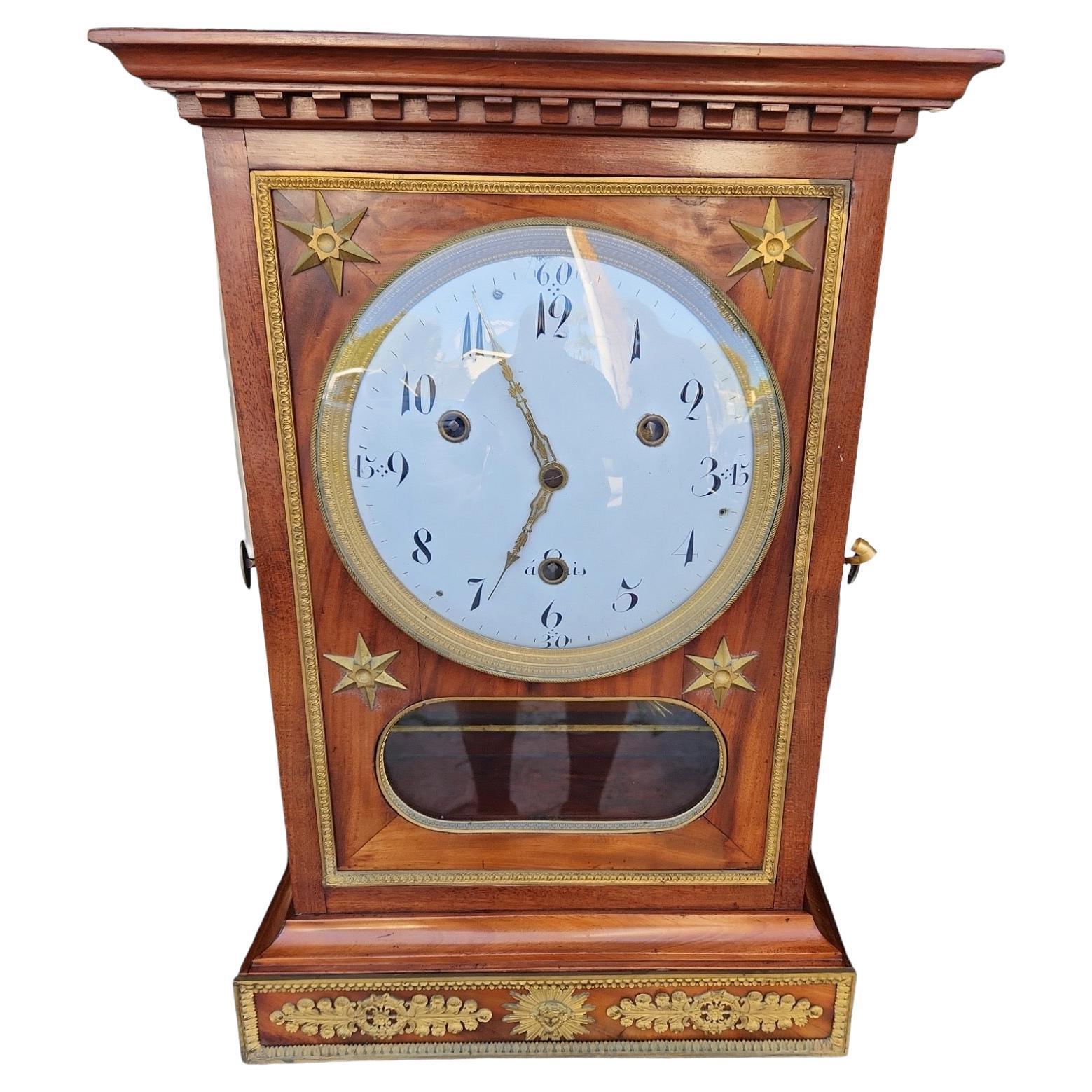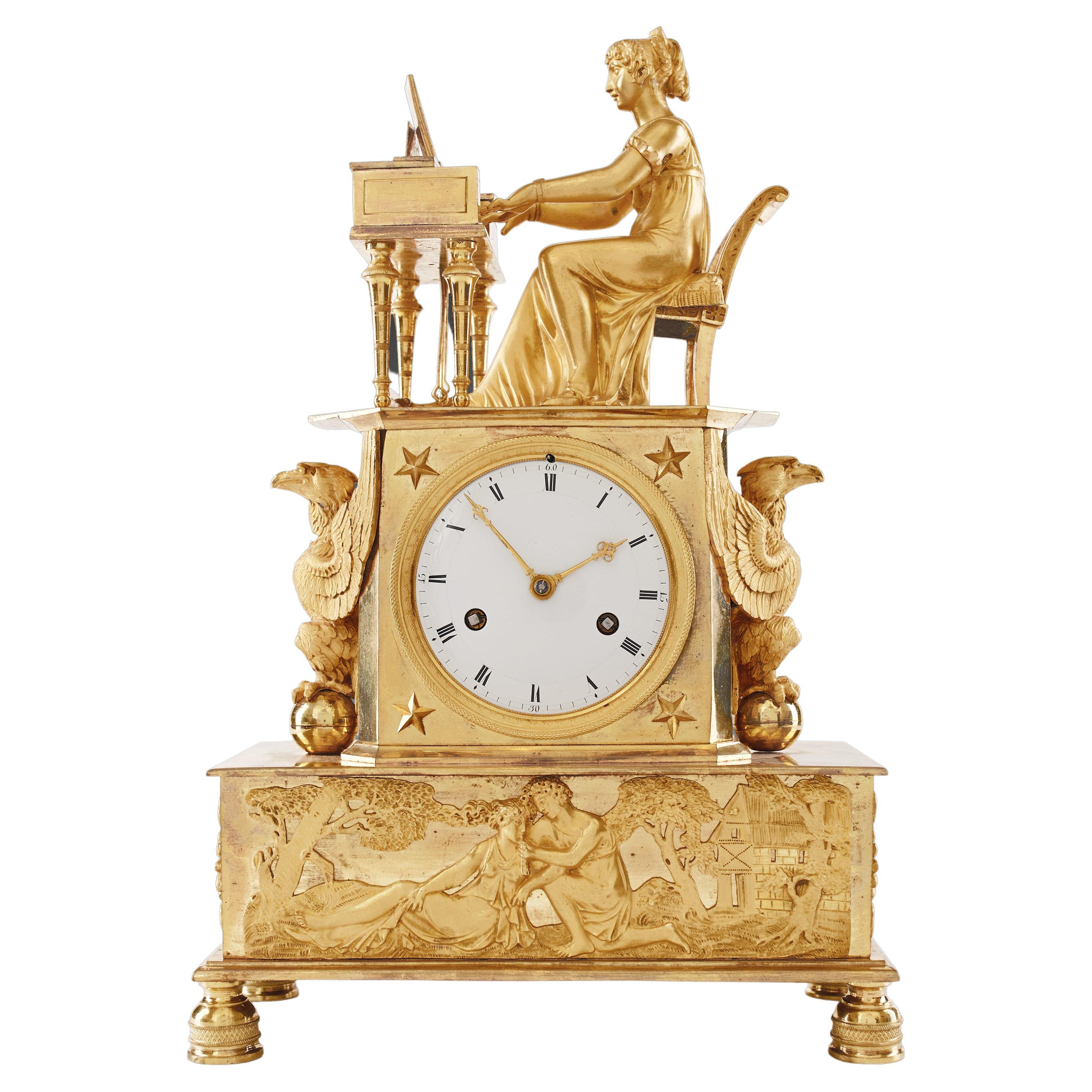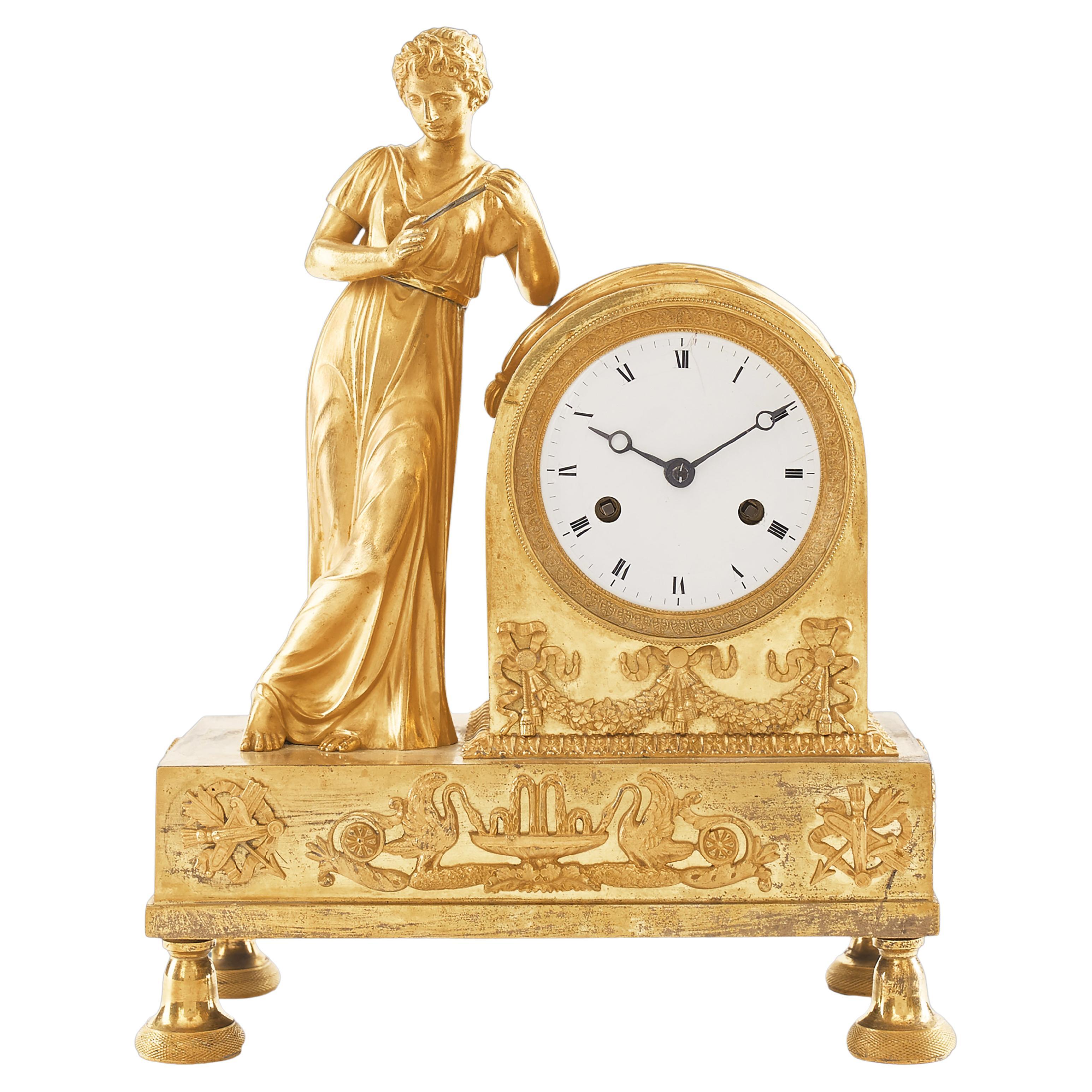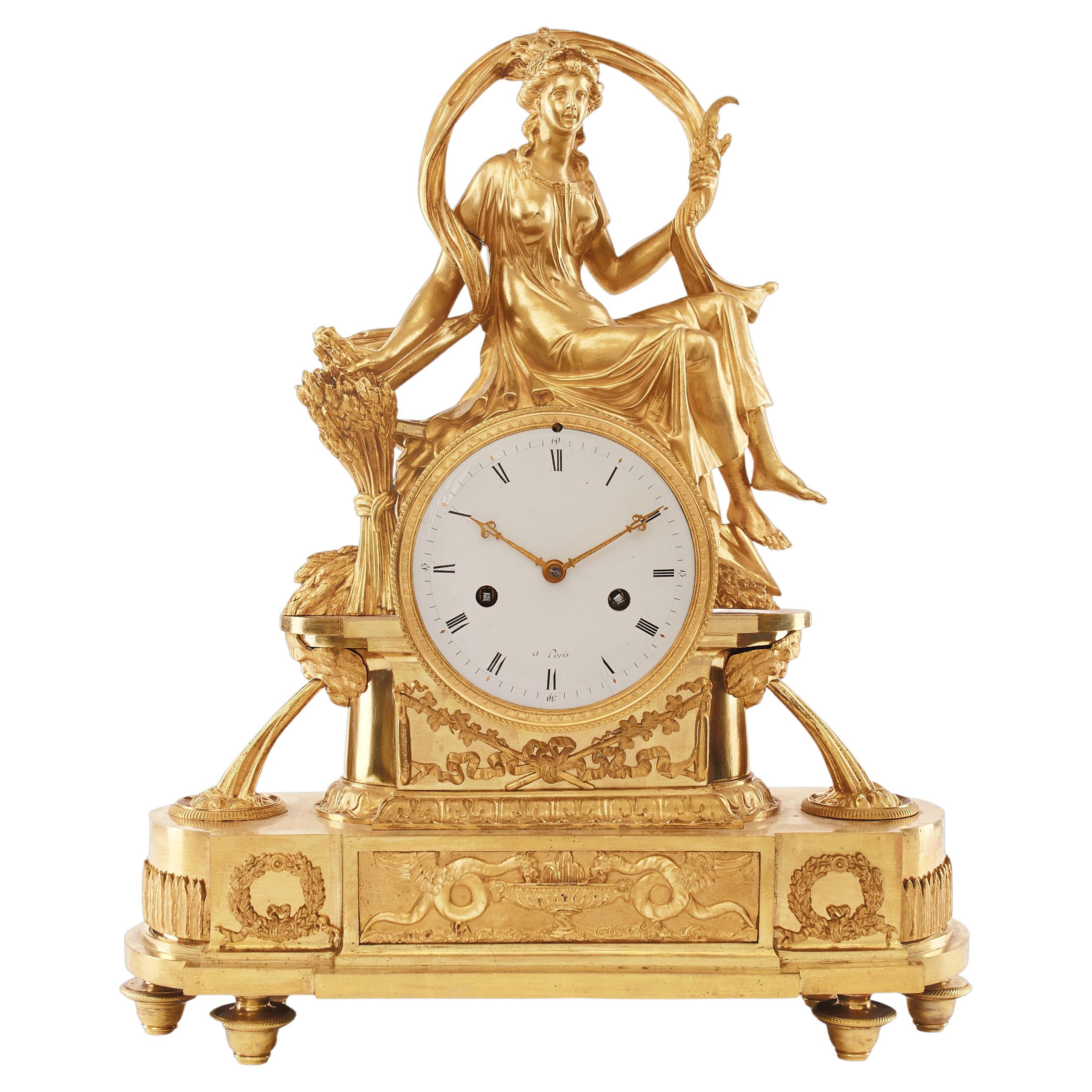Items Similar to Mantel Clock 19th Century Empire
Want more images or videos?
Request additional images or videos from the seller
1 of 9
Mantel Clock 19th Century Empire
About the Item
Figural mantel clock signed “Al. dre Destape Palais Royal”
The bronze figural mantel clock depicting one of the mythical heroes - Orpheus originates from the Empire period. The clock is made in a characteristic Empire style, a major phase of Neoclassical art that flourished in France during the time of the First Empire in the 19th century. Bronze was the main material used in Empire style timepieces and both the patina and ormolu techniques were vastly used for ornamentation during this period. The use of gilt-bronze has reached its peak at the beginning of the 19th century in France, as it was cheaper than gold or silver. For this reason, it became the favourite material for clock cases, ornamental elements, candelabra and furniture ornaments. Owing to the skill of remarkable bronze casters and chasers these objects were not merely timekeepers but became objets d'art. Many of the characters and scenes inspired by Greco-Roman antiquity presented on the Louis XVI style clocks made appearances on the clocks produced in the first quarter of the nineteenth century. However, the style was completely changed and the clocks were more amiable.
This beautiful ormolu bronze mantel clock is surmounted by a bronze sculpture of Orpheus, and according to some Greek myths, was the son of Apollo and the muse Calliope, who also was endowed with extraordinary musical skills. The figure of Orpheus on the clock is modelled with a gold lyre in his hands that is known to be a gift from the god Apollo. Moreover, the lyre became Orpheus symbol because of his adventures and the contributions it had in them. He was the first one to perfect the skill of playing the lyre, as a result, his music could charm animals, trees, beasts, divert the course of rivers or even convince gods to change their will. The most popular myth featuring Orpheus was about his journey to the Underworld to retrieve his deceased wife, which he loved tremendously. Unfortunately, the story ended tragically and he never retrieved his wife back. His motivation and power of love became his main traits.
Many elements featured on this mantel clock represents Orpheus and his extraordinary skills at playing instruments. The lyre which Orpheus is holding stands on the gilded bronze clock case next to a floral wreath with a burning torch inside it. On the opposite side of the clock case, is a gilded bronze bouzouki with a matching foliage motif to the lyre.
Besides the figure of Orpheus, the second main feature of this clock are the reliefs that adorn the clock case as well as the rectangular plinth.
The case of the clock is build of a large ormolu bronze pedestal. The enamel dial is encircled by Roman numerals for hours and minutes. To indicate the time the clock uses blue Breguet-style hands, which have a circle with a filled crescent shape on the side. This unique shape is sometimes referred to by the French word for apple, pomme. The dial is also signed “Al. dre Destape Palais Royal” at the bottom. Surrounding the dial are beautiful rose reliefs, and beneath them is relief with a burning torch accompanied by foliage garland and wreath. The pedestal clock case is framed at the bottom with a rais-de-cœur motif, that also features at the bottom of the base trim.
The plinth is also decorated with reliefs, however, they are separated into three medallions. The two medallions which are situated on the left and right side depicts a rose wreath encircling two crossed arrows with an undulating ribbon tied to them. The medallion in middle shows a dragonfly, goose, laurel leaf branches with berries and ancient Greek musical instruments, all representing Orpheus ability to charm with his music.
The ormolu clock stands on the chiselled and gilded bronze ball feet.
Literature
An identical model of this clock can be found in the Pierre Kjellberg, "La Pendule Française du Moyen Age au XXe Siècle", 1997, p. 405, pl. D with minor differences, which is the lack of a burning torch in a floral wreath.
- Dimensions:Height: 21.26 in (54 cm)Width: 13.39 in (34 cm)Depth: 5.12 in (13 cm)
- Style:Empire (Of the Period)
- Materials and Techniques:
- Place of Origin:
- Period:
- Date of Manufacture:1820-1830
- Condition:Rewired: The clock is in a excellent and perfect working condition. Also it has recently been cleaned and serviced by a professional clock maker.
- Seller Location:Warsaw, PL
- Reference Number:1stDibs: LU5826227424212
About the Seller
5.0
Vetted Seller
These experienced sellers undergo a comprehensive evaluation by our team of in-house experts.
Established in 2021
1stDibs seller since 2021
22 sales on 1stDibs
Typical response time: 8 hours
- ShippingRetrieving quote...Ships From: Warsaw, Poland
- Return PolicyA return for this item may be initiated within 3 days of delivery.
More From This SellerView All
- Mantel Clock 19th Century Styl EmpireLocated in Warsaw, PLThis ormolu clock from the 19th century has a rectangular base with four feet carved with small patterns. The figure on top represents a lady playing on the spinet and on sides of th...Category
Antique Early 19th Century French Empire Mantel Clocks
MaterialsBronze
- Mantel Clock 19th Century Styl EmpireLocated in Warsaw, PLEmpire style figural mantle clock from the beginning of the 19th century. This mantel clock is known also as the “Allegory of love”, as the woman featured in this clock is holding on...Category
Antique Early 19th Century French Empire Mantel Clocks
MaterialsBronze
- Mantel Clock 19th Century Styl Empire by Cérés À ParisLocated in Warsaw, PLEmpire clock signed à Paris The mantel clock is in gilded bronze representing Ceres as a goddess of fertility, agriculture, grain crops and motherly relationships. In ancient Rom...Category
Antique Early 19th Century French Empire Mantel Clocks
MaterialsBronze
- Mantel Clock 19th Century Styl Empire by Bouzzeb À ParisLocated in Warsaw, PLThe mantel clock, made of ormol (gilded bronze), shows the beautiful figure of Diana, the Roman goddess of the hunt, accompanied by various emblems. Diana is sitting on the circular ...Category
Antique Early 19th Century French Empire Mantel Clocks
MaterialsBronze
- Mantel Clock 19th Century Styl Empire by Leroy à ParisLocated in Warsaw, PLMantel clock 19th Century Empire Le Roy et fils (French, founded 1785) Le Roy et fils was a prestigious French clock making firm. The company was fou...Category
Antique Early 19th Century French Empire Mantel Clocks
MaterialsBronze
- Mantel Clock 19th Century Styl Empire by Hartmann À ParisLocated in Warsaw, PLThe clock is in excellent and perfect working condition. In addition, it was recently cleaned and serviced by a professional clockmaker who specializes in maintaining museums. The e...Category
Antique Early 19th Century French Empire Mantel Clocks
MaterialsBronze
You May Also Like
- 19th Century Empire Mantel ClockLocated in Los Angeles, CAExcellent condition with finely chased dore bronze mounts. Has key and pendulum.Category
Antique Early 19th Century French Empire Mantel Clocks
MaterialsBronze
- 19th Century Empire Ormolu Mantel Clock, FidelityLocated in Paris, FREarly 19th century Empire clock crafted of gilt bronze, or ormolu, featuring an allegorical scene with a woman sitting at her work table play...Category
Antique Early 19th Century French Empire Mantel Clocks
MaterialsBronze
- 19th Century Empire French Black Marble Bronze Mantel ClockLocated in Roma, RMBronze and marble mantle clock - France, Paris 18th century, signed GREBER Black marble temple case with gilt bronze lions. Circular dial with Roman nume...Category
Antique 1810s French Empire Mantel Clocks
MaterialsBelgian Black Marble, Bronze
- Antique Mid 19th Century Marble Empire Chime Mantel ClockLocated in Charlotte, NCAn antique Empire style marble chime mantel clock, unbranded. White marble encasing the clock works. Round decorative brass encased glass covered clock face has Roman numbers marking...Category
Antique Mid-19th Century Unknown Empire Mantel Clocks
MaterialsMarble, Brass, Metal
- Early 19th Century Viennese Empire Carved Wood Mantel ClockLocated in Worpswede / Bremen, DEThe octagonal shaped case surmounted by a classical vase on dolphin supports, white enamel dial, eight-day going clock movement striking the half- and full hours.Category
Antique 19th Century Austrian Empire Mantel Clocks
MaterialsGesso, Wood
- Early 19th Century Empire Mantel Clock with Cupid in a ChariotBy Marie PrevostLocated in Paris, FRExceptional gilt bronze mantel clock with its key depicting a winged Cupid in a chariot. The chariot is pulled by two doves that are resting on a platform adorned with water-leaf. Th...Category
Antique Early 19th Century French Empire Mantel Clocks
MaterialsBronze
Recently Viewed
View AllMore Ways To Browse
19th Empire
For The Empire
Nevers 19th
Empire Feet
Blue Empire
First Empire
First Empire Furniture
French Empire Art
Silver Clock Antique Clocks
Antique Silver Clock Antique Clocks
Ancient Empires
Gilded Clock
Gilded Mantel
Empire Figure
Antique Clock Art
Manyal Clocks
French 19th Century Bronze Gilt Mantel Clock
Antique Empire De





